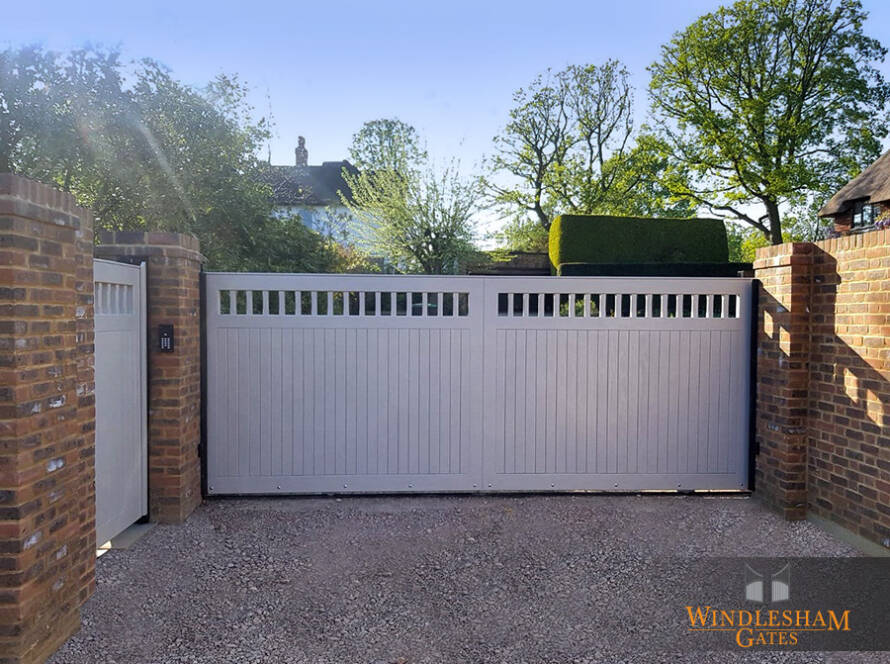If you’ve ever found yourself stepping out of your car in the pouring rain to open your driveway gates, or worrying whether you remembered to close them after leaving home, you already understand the frustrations that lead many homeowners to choose automated driveway gates. Their appeal goes far beyond convenience; it’s about security, control, and peace of mind. But what truly transforms a gate from a simple mechanical barrier into an intelligent, responsive system are the sensors that power it.
At Windlesham Gates, we’ve spent years perfecting the design, manufacture, and installation of automatic electric gates. As one of the UK’s leading specialists in automatic gate installation, we combine expert engineering with the latest automation technology to deliver systems that are as safe and reliable as they are elegant.
Whether you’re upgrading your home’s entrance or managing access to a commercial property, the sensors within your automated gate system are the invisible guardians that make daily operation effortless and secure. In this guide, we’ll explore how these sensors work, the types available, how they integrate with automation, and the key practices that keep them functioning flawlessly for years.
Understanding the Role of Gate Sensors
Modern automatic gates are more sophisticated than ever before. They open seamlessly at your approach, respond to safety signals instantly, and can even integrate with your home’s smart technology. At the heart of this sophistication are the sensors that detect motion, presence, and obstacles. These devices ensure your automated driveway gates remain both secure and intelligent, protecting vehicles, people, and property.
Every automatic gate installation involves careful consideration of which sensors to use and where to place them. Each sensor type performs a specific task: some ensure safety, others manage access, and many contribute to overall automation efficiency. Let’s take a closer look at the main types used in today’s systems.
Types of Gate Sensors
Photocells/Safety Beams
Photocells are among the most common automated gate safety sensors. They consist of a transmitter and receiver installed across the gate opening. An invisible infrared beam passes between them. If the beam is interrupted (for example by a person, vehicle, animal), the sensor triggers the gate control to stop, reverse, or pause the motion.
They are typically mounted a short distance from the gate edge so that the motion of the gate itself does not interfere with the beam during normal operation.
Inductive Loop Sensors (Vehicle Detection Loops)
Loop detectors open automatic gates when vehicles approach (exit loops or entry loops), negating the need for remote controlled operation. Loop sensors are often buried beneath the driveway in a loop of wire. When a vehicle (or metal mass) passes over or enters the loop, it changes the electromagnetic field, which triggers a signal to the gate controller to open or hold the gate open.
Safety Edges/Pressure Sensors
Safety edges are physical contact sensors usually mounted on the trailing edge of a moving gate leaf. If the gate leaf comes into contact with an object or person, the pressure or compression on that safety edge triggers the system to stop or reverse the automated gate.
They are often made with rubber or flexible materials containing internal wiring that completes a circuit when compressed.
Magnetic/Proximity Sensors
These detect the presence or movement of metal objects (vehicles) through changes in the magnetic field. They can be used for access control or as part of a detection system to open or hold a gate for a vehicle. Magnetic sensors may operate similarly to loops but with smaller footprint or different installation constraints.
Smart Features and Integrations
Beyond basic safety and detection, modern automatic gates increasingly support smart integrations:
- Access control systems (such as keypads, intercoms, card readers, biometric systems) can work in tandem with sensors so that only authorised users trigger gate opening.
- Vehicle detection and timing logic: for example, using a loop detector in conjunction with photocells, the system can decide when to begin closing only after a vehicle has fully passed.
- Remote monitoring/alerts: sensors feed into central control systems that can notify homeowners or system managers of faults, obstruction events, or tampering.
- Home automation/smart home integration: sensors can trigger lights, CCTV, alarm systems, or notifications when motion or presence is detected near the gate.
- Adaptive behaviour: for example, in congested periods, the gate might remain open longer; or during storms, the system may behave more conservatively to avoid false triggers.
By combining safety and detection sensors with automation logic, your gate becomes more than just a barrier — it becomes a proactive sentinel.
How Sensors Work with Automation
To see how all these parts work together in an automatic gate installation, here’s a simplified flow:
- Detection/Triggering
A loop detector senses an approaching car → sends a “vehicle present” signal- Or, a user enters a code on a keypad or pushes a remote
- Or, a photocell beam is broken (e.g. someone in the path)
- Control Board Decision
The gate’s control board (logic unit) receives sensor signals and runs programmed logic (open/close timing, safety protocols, priority signals). - Motor Activation
If conditions are safe (no obstruction, no conflicting signal), the board powers the motor to open or close the gate. - Monitoring During Movement
During motion, safety sensors (photocells, safety edges) continuously monitor for obstructions. If something interrupts a beam or the safety edge is compressed, the control board halts or reverses movement. - End Position & Locking
Once the gate reaches its limit switch (fully open or fully closed), the motor stops and the system may trigger locking or hold mode. - Fallback/Manual Override
In power failure or sensor fault conditions, manual override systems or mechanical release options allow the gate to be operated by hand.
This orchestration ensures that automated driveway gates are both functional and safe.
Automatic Gate Installation Best Practices
When planning an automatic gate installation, good sensor placement and design are crucial. Here are some best practices that experienced installers should follow:
- Sensor height & alignment: Photocells should typically be installed around 400–800 mm above ground (or per manufacturer spec), and precisely aligned so the beam is straight and unobstructed.
- Setback from gate leaf: Safety beams should be placed at a distance ahead of the moving gate leaf so that motion of the gate doesn’t interrupt its own beam.
- Redundant beams: In many systems, dual photocell pairs (one closer, one further) are used so that the gate only begins to close after both beams have re-established, reducing the risk of premature closing.
- Loop detector placement: locate loops well within drive, avoid metal in fill, ensure correct depth and isolation, and route cables carefully away from interference.
- Protection and shielding: sensors and cables should be protected from mechanical damage, water ingress, or tampering. Use weatherproof housings and buried conduits for underground wiring.
- Integration with control logic: ensure safety sensors outrank convenience sensors (i.e., safety always triggers override).
- Testing & calibration: after installation, thoroughly test all sensors, ensure correct response to obstruction, test boundary cases and emergency functions.
- Compliance with standards: adhere to relevant safety regulations and standards for automated gates (in the UK, Gate Safe and BS EN 12453/BS EN 12445 may apply).
Sensor Maintenance Tips
Maintaining sensors ensures longevity and reliable operation. Key practices include:
- Clean lenses & surfaces regularly — dirt, spider webs, leaves or algae can block photocell beams or reduce detection sensitivity.
- Inspect sensor alignment — sensors can be knocked out of alignment over time due to vibration, frost or settling.
- Check cables and connections — wiring should be intact, insulation good, no rodent damage, and connectors sealed.
- Test safety and reversal functions periodically — place an obstruction in the beam path (or lightly compress safety edge) and confirm the gate stops/ reverses.
- Ensure loop detectors remain functional — check for seasonal changes (moisture saturation, freezing) that might affect loop inductance.
- Firmware/software updates — if the control system is updatable, keep it patched for bug fixes, improved detection logic or security enhancements.
Regular servicing of your automated gates helps maintain safety, security, and performance.
FAQs about Automated Driveway Gates
Q: Are automatic gate sensors reliable in all weather?
A: Yes — high-quality sensors (photocells, loops, safety edges) are designed for outdoor conditions. However, heavy fog, rain, or snow may occasionally interfere with infrared beams, so redundancy and shielding improve reliability.
Q: Do sensors reduce security by letting entry?
A: Good systems differentiate detection sensors (for opening) from access control sensors (for authorising access). Safety sensors don’t grant access—they only prevent collisions. Access is still governed by remotes, keypads or control logic.
Q: Can existing manual gates be retrofitted with sensors?
A: Absolutely. Many manual or bolt‑operated gates can be upgraded to automatic gates with sensor systems added — though correct design and installation is key to safe integration.
Q: What’s the difference between an automatic gate and an automated gate?
A: They are often used interchangeably. Automatic gates emphasise self‑operation (opening/closing), while automated driveway gates suggest integration with control systems, sensors, and smart features. In practice they overlap heavily.
Automatic Gate Sensors: Turning Everyday Entrances into Intelligent Systems
Sensors are the unsung heroes of automatic gates, turning them from static barriers into intelligent, secure systems. From photocells and loop detectors to safety edges and magnetic sensors, these components safeguard users, provide smart control and integrate with modern gate systems.
A well‑designed automatic gate installation will use the right combination of sensors, placement precision, calibration and ongoing maintenance to deliver both security and convenience.
If you’re considering upgrading to automated driveway gates or need expert help designing a sensor system for your existing gates, contact Windlesham Gates today. Book a consultation and let us ensure your gate is safe, smart and built to last.



